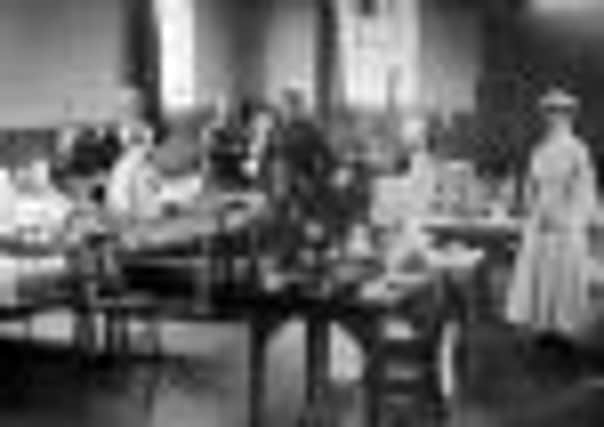Village’s Great War link is revealed on internet


Dozens of photographs of First World War soldiers convalescing in an English village after being wounded on the Western Front were posted on the internet yesterday by members of a new local history society.
Pictures show injured soldiers being cared for at a temporary military hospital in Shepreth, Cambridgeshire, nearly 100 years ago.
Advertisement
Hide AdAdvertisement
Hide AdThe black and white snaps show nursing staff and wounded soldiers in a pristine makeshift ward, created in the village hall. It is a world away from the conditions soldiers would have endured on the battlefield, with a collection of plants, flowers and cards, neatly arranged.
In another picture, a wounded serviceman, sits in a wheelchair, draped in a Union Jack blanket.
The images were posted on the website of the Shepreth Memory Preservation Society – www.oldshep.co.uk – as Britain prepares to mark the centenary of the outbreak of the conflict in 2014.
Two years ago a postcard written to a Great War soldier in 1915 was found behind a wooden panel in Shepreth Village Hall, which was used as a military hospital between 1914 and 1919.
Advertisement
Hide AdAdvertisement
Hide AdVillagers said several people, whose relatives had worked as nurses at the hospital, revealed that they had Great War photographs in family albums after reading about the discovery of the postcard.
Website designer Jordan Smith – one of the founders of the Shepreth Memory Preservation Society – has collated the images and included them in a feature about Shepreth during the First World War.
“Several families very kindly said we could copy the photographs and we felt that as many people as possible should be able to see them,” said Mr Smith, 20, who grew up in Shepreth.
“We hope people find them as fascinating as we do. They show servicemen with nurses in and around the village hall – which hasn’t changed that much in the past century.”
Advertisement
Hide AdAdvertisement
Hide AdHe added: “We very much hope that people will recognise some of the faces in the pictures and tell us something about them.”
In December 2010, carpenter Alan Payne found a postcard, addressed to Private Edward Wolstencroft of the Royal Fusiliers, while fixing the Shepreth Village Hall floor.
Research by villagers revealed that the card had been sent by Pte Wolstencroft’s sister Nellie.
Records also showed that he died in 1916 during the Battle of the Somme.
Advertisement
Hide AdAdvertisement
Hide AdHistorian Chris East traced Pte Wolstencroft’s family and villagers presented the card to a relative.
Nellie’s postcard was found behind a wooden panel near the main entrance to hall. It is thought the card must been placed on a ledge on top of the panel then slipped down out of reach.
Photographs of Great War servicemen being treated in the hall show cards sitting on the panel ledge near beds.
The postcard’s cover photograph shows a “sailor” linking arms with two women above the slogan “All the nice girls love a sailor.”
Advertisement
Hide AdAdvertisement
Hide AdNellie’s postcard – and the village hall – gave the society enough clues to trace details of Pte Wolstencroft’s life.
There is a clock in the village hall wall bought by Great War soldiers as a thanks to villagers. A scroll below lists servicemen who featured in a fund-raising concert. In the list the society found: “Drummer Wolstencroft”.
It seems that the card was sent to Royston first and then forwarded to Shepreth.
Nellie had written Pte Wolstencroft’s name, rank, number and unit. Checks of military – and census – records showed that Pte (Drummer) Edward Coulton Wolstencroft, of the Royal Fusiliers, came from Edmonton, Middlesex, and disappeared on July 7, 1916 – a week after the start of the Battle of the Somme – when he was in his mid-20s.
Advertisement
Hide AdAdvertisement
Hide AdIt is believed that some of the photographs were taken by hospital matron Amy Webber, who lived at Wimbish Manor with husband Mowbray and daughter Mona.
The photographs – which are almost a century old – show soldiers posing with nurses, watching as a flag is raised, enjoying a smoke while dressed in “hospital blues” and slippers and preparing for a concert or dance.
Servicemen and nurses are seen inside and outside the hall and in tents.
Several of the original snapshots featuring the wounded servicemen are marked with names, details and dates.